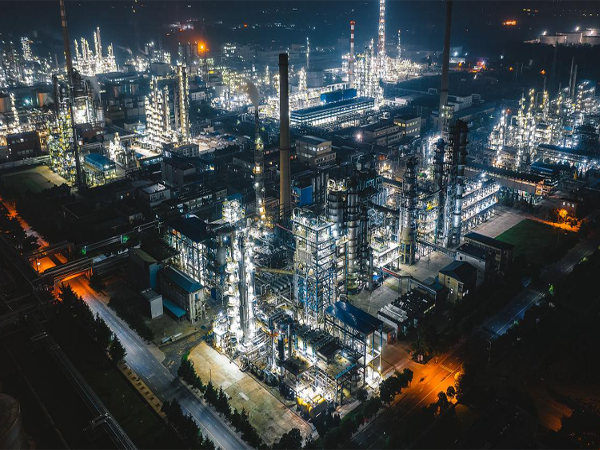
Titanium heat exchangers, condensers, and related auxiliary equipment have been successfully used in petrochemical enterprises for over 20 years. The most commonly used industrial pure titanium in titanium materials (with TA2 being the most widely used), Ti-6Al-4V (when a certain strength is required), and Ti-0.8Ni-0.3Mo (when there are gaps or in non oxidizing media).
(1) Titanium equipment is ideal for refining crude oil with high sulfur and salt content. Titanium equipment has been successfully used in many processes abroad, such as atmospheric distillation units, sewage treatment equipment, condensers for desulfurization and separation towers, and radiators for stripping towers, for many years. China has also adopted cast titanium seawater pumps, titanium condensers in catalytic cracking fractionation, cryogenic separation titanium condensers, and porous titanium plates in this system, all of which have been operating normally for more than ten years.
(2) Chlorinated hydrocarbons are one of the largest varieties in petrochemical industry. Due to the chlorination reaction involved, stainless steel equipment is no longer competent. Titanium materials have been used abroad to manufacture dichloromethane distillation towers, trichloroethane heat exchangers, condensation and fractionation towers, trichloroethylene condensation towers, perchloroethylene heat exchangers, and polychloride coil heaters. In the production of vinyl chloride in China, the support brackets, connecting pipes, and flange sealing surfaces of cooling towers, wastewater stripping towers, and wastewater storage tanks are lined with Ti-0.2Pd, and have not been corroded for nearly ten years. Titanium pipes, joints, and gas distributors have been made of titanium for many years.
(3) Phenol is an important raw material in petrochemical industry. It is a new process that uses propylene and benzene in refinery gas as raw materials to obtain phenol and acetone from isopropyl benzene and isopropyl peroxide. Titanium equipment was used abroad more than a decade ago, while this process is still under development in China. The old process used benzene sulfonated alkali solution to produce phenol. China has adopted titanium neutralization reaction kettle, titanium coil cooler, and agitator shaft sleeve of ion nitrided titanium, with good results.
(4) In the equipment for the oxidation of ethylene to acetaldehyde, acetaldehyde to acetic acid, and propylene to acetone, the main corrosive medium is the catalyst, except for the raw materials and products that have certain corrosiveness. Stainless steel corrodes quickly in it, and only titanium has good corrosion resistance. As early as 1963, the United States successfully applied titanium in the production of ethylene oxidation to acetaldehyde. The first ethylene oxidation to acetaldehyde plant in China was put into use in 1976, and the titanium equipment has been operating well since then. Foreign titanium lined reactors have a diameter of up to 9.6m and a diameter of 3m, as well as 11 titanium equipment such as heat exchangers, catalyst regeneration towers, and acetaldehyde solution coolers. After the 1980s in China, Shanghai and Jilin respectively introduced complete sets of equipment for ethylene oxidation to acetaldehyde from abroad. Many of the equipment and pump valves were made of titanium, which had obvious advantages over stainless steel and had very satisfactory results. The finalized design of propylene oxidation to acetone includes 12 titanium equipment, a factory with an annual output of 30000 tons of acetone, and a titanium equipment capacity of 40 tons.
(5) Acetaldehyde oxidation to acetic acid is a common process in China, and titanium materials have been used as high boiling reboilers, first grade acetic acid tower reboilers, and condenser coolers, among other equipment. Titanium equipment has been used in distillation towers, fractionation towers, and distillation towers abroad. Especially in the oxidation of low-grade alkanes to acetic acid, there are many by-products, with a formic acid content of 8% and strong corrosiveness. At this time, titanium is used instead of stainless steel, and the effect is very ideal.
(6) Terephthalic acid is a raw material for synthesizing polyester, which is produced industrially by the oxidation of xylene. Both high-temperature oxidation and low-temperature oxidation exhibit high-temperature corrosion by acetic acid and bromide. In a medium with a temperature above 135 ℃, 316L stainless steel undergoes pitting corrosion after several tens of hours. Therefore, the design specifications stipulate that titanium materials must be used above 135 ℃.
(7) Urea is a high-quality fertilizer and a raw material for petrochemical industry. Since the first titanium lined urea synthesis tower was put into operation in 1963, nearly 10000 equipment have been operating worldwide. Practice has shown that the titanium lined synthesis tower has no obvious corrosion. The converted corrosion rate of 316L stainless steel is 4.1-4.5mm/a. Therefore, titanium has better economic benefits than stainless steel. In addition to titanium lined urea synthesis towers, since the 1970s, China has successively used C02 stripping towers, heat exchangers, mixers, and pump valves.